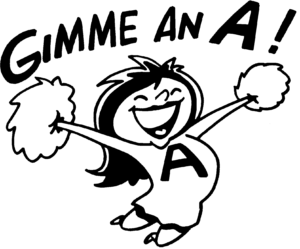
One workshop participant asked this question about grading customer service excellence:
“I’m designing a performance measurement system for our in-house technology team and have run into a disagreement with my boss.
“He would grade a support technician as ‘A’ if the Service Level Agreement (SLA) norms have been met, and ‘A+’ for any additional enthusiasm shown.
“I want to give only 50% for meeting the SLA norms since these are non-negotiable specifications. The remaining 50% I would give for enthusiasm, special assistance and ongoing development of the expert. What do you think?”
Here is my reply:
You need to clarify with your boss and the rest of the in-house team what an “A” should actually stand for in regard to customer service excellence.
In most schools, “C” is “satisfactory” – which means all the “non-negotiable” specifications have been met. I also refer to this as “customer satisfaction.”
“B” is “good” (B+ is very good) – which means all specifications are met and the work is done with some notable level of enthusiasm, individual initiative, etc. This is the domain of “customer delight,” but not necessarily customer service excellence.
“A” is for “outstanding” – which is reserved for performance well above and beyond the call of duty. “A” is for extra-mile effort that brings the customer, or the company, to a new level of performance and customer service excellence.
“A+” is legendary, a breakthrough, a brand new benchmark for others to remember, admire and follow. This is where your customers become ambassadors, enthusiasts, fanatics and devotees due to superior customer service excellence.
To my mind, an “A” should not be given for simply “doing the job.” “Doing the job” is just expected, merely satisfactory. That’s a “C.”
Doing more than the minimum job is where higher grades should be awarded.
I recommend you bring together your in-house customers and the members of your technology support team. Encourage discussion. Let there be a healthy debate about what equates to customer service excellence.
Ultimately, agree on what A, B, C, D and F will stand for in your unique context. Then grade accordingly.
Key Learning Point For Customer Service Excellence
Within an organization, departments may have very different opinions about how well they are doing, and how well, or poorly, other departments around them are performing. These disagreements stem from a lack of clear standards for evaluating internal service and customer service excellence. This can lead to misunderstanding, inter-departmental tension and low motivation and morale.
Setting clear standards provides a platform for better communication. Raising standards over time is a pathway to continuous improvement and customer service excellence.
Action Steps For Customer Service Excellence
If your department supports, relies upon or works closely with another department, call a meeting to review or create agreed service and performance standards.
Use these questions to get the conversation rolling: How do you know when you are doing a good job? How do you know when other departments are doing a good job? What do you consider “satisfactory” inter-departmental performance? What constitutes “above average?” What could another department do that would delight you, astound you or have you stand up and applaud?
This commitment to setting clear standards is useful for internal support situations. You can – and should – use this approach with your external customers, too.
——————————————————————————————————————————
You may use this article in your free newsletter, website or publication providing you include this complete statement (below) with active links to the websites:
Copyright, Ron Kaufman. Used with permission. Ron Kaufman is the world’s leading educator and motivator for upgrading customer service and uplifting service culture. He is author of the bestselling “Uplifting Service” book and founder of Uplifting Service. To enjoy more customer service training and service culture articles, visit www.RonKaufman.com.
For commercial use of this article in a paid newsletter, publication, or training program, please contact us.



